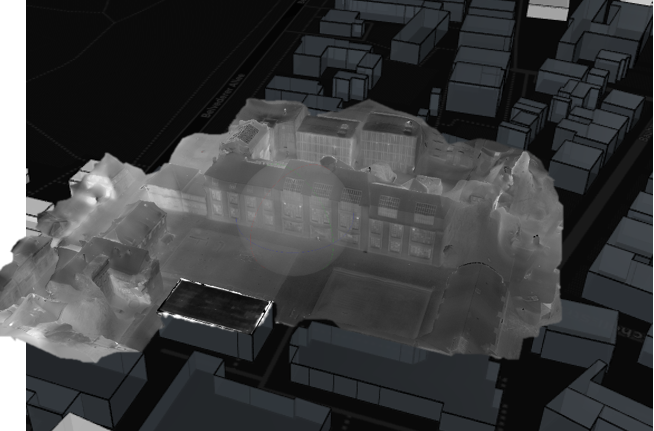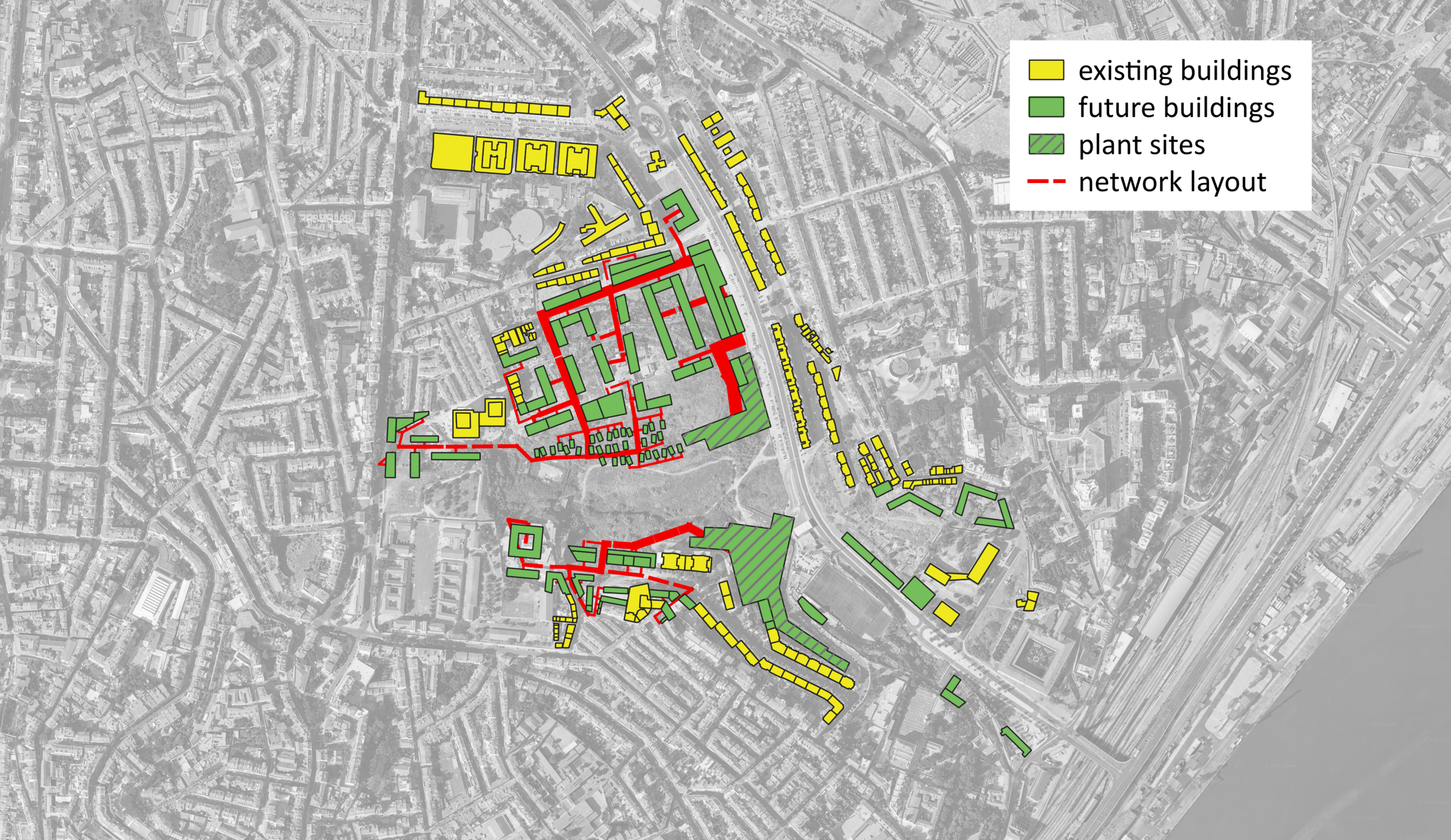We want to hear how you use CEA in your projects!
Please click here to arrange a meeting with the CEA Team.
Projects
CEA is an R&D endeavor fed by results from real applications . As a result, we have partnered with industry, academia and governance to test CEA in real urban areas and case studies. Current case studies include mixed-use districts in Singapore and Zurich.
Bauhaus, DE - Bauhaus 2050 & Bahhaus 2050+
Thuringia, DE - SMOOD
Singapore, SG - Building Integrated Agriculture (BIA)
Lisbon, PT - Vale de Santo António
Vancouver, CA - Wesbrook Village
Singapore, SG - Cooling Singapore
Amsterdam, NL - Buiksloterham
Bauhaus2050: Energy efficient refurbishment of city quarters reducing CO2 emissions allowing for heritage listed building stock in Weimar
Future city quarter development in the discourse of energy efficiency and resource depletion requires further development of planning methodologies in terms of planning processes and instruments. The energy efficiency potential of large existing building stock will be analysed for building skin retrofit, energy supply systems updates and feasible synergies. By shifting the focus from the single building to the city quarter, the overall CO2 emission reduction of the cluster can be obtained.
The campus of the Bauhaus Universität Weimar will be analysed as a case study for larger building stocks to determine the energy efficiency potential of building skin retrofits, energy supply systems updates and feasible synergies. The campus of the university is located within the city centre with a significant share of heritage-listed buildings. Furthermore, five of the 32 buildings are not only heritage protected; moreover, they are part of the UNESCO World Heritage and hence, building envelope measurements are simply not applicable. The building stock of the surrounding quarter is characterised by mixed use of varying building typologies and ages; the ground floor often houses retail or crafts; the upper floors are mainly residential units. In combination with the university functions, the quarter focuses on the preservation of a liveable, mixed-use neighbourhood that allows for the coexistence of living and working as a key parameter to sustainable cities. Instead of evaluating the potential of a single building, extending the perimeter to the quarter will help to identify synergies that only exist in building ensembles of varying functions and their occupancy profiles and load profiles respectively. Furthermore, new developments in brownfields might be able to support CO2-neutral local energy production to reduce the overall CO2 emission balance.
CEA provides an energy demand model and CO2 reduction scenarios for a campus quarter consisting of listed buildings and existing building stock.
The project produces a refined model with buildings-specific collected data for construction, refurbishment and envelope (u-value by thermographic drone flights); a model calibration with RL data; two campus networks: CHP & GSHP; integration of renewables (ST, PV, PVT, geothermal).
Funded by: The German Federal Environmental Foundation (Deutsche Bundesstiftung Umwelt - DBU)
Project duration: 11/2017 - 10/2020
Contact person: Anja Willmann (anja.willmann@fb1.fra-uas.de)
Bauhaus2050+
Bauhaus2050+ is extending the district of the Bauhaus2050 project by applying the methodology to two further campus areas of the Bauhaus University within the city of Weimar: the university sports hall and a campus district at Coudraystrasse with an intensive lab quantity. In addition, this project focuses on improved and automated data collection for heterogenous city districts, i.e. drone flights for geometrical information and thermal properties of the building skins.
CEA provides an energy demand model and scenarios for carbon reduction for mixed-use buildings/campus buildings/mainly labs.
The projects integrated mixed-use buildings with more than three use types refined lab use/load for university labs by means of RL data.
Funded by: Bauhaus University Weimar
Project duration: 2019 - 2022
Contact person: Alexander Benz (alexander.benz@uni-weimar.de)
Image credit: Determining u-values by thermographic drone images (Alexander Benz)
Establishment of a holistic system for increasing energy efficiency in urban districts – smood®.
A group of seventeen companies and four research institutes in the Central Thuringia region worked on a strategy for energetic retrofits to create liveable, efficient and environmentally friendly residential areas in the future. Urban districts were converted to energy-efficient districts with a high level of self-sufficiency in renewable energy technologies. The experts at "smood" combined newly developed technologies for energy generation and storage with established techniques such as photovoltaics, and solar thermal or geothermal energy to create an optimized system.
The fundamental goal of the sub-project “ScanSim - Neighborhood-related Data Acquisition and Processing” was to develop a process to perform the basis for planning and to generate a retrofit plan. New methods and procedures for data acquisition (smoodCAPTURE) as well as data storage (smoodQIM) and data evaluation (smoodSIM) were developed to perform an innovative process. The combination of modern technologies such as drone-based condition assessment and methods of computer vision, urban building energy modelling and data recording on geographic context opened up new possibilities for a digital and fully automated process.
The project developed a database for Germany, used open GIS data as input data for CEA, and integrated xls-format files containing individually collected data to refine statistical data of the buildings.
Funded by: Federal Ministry of Education and Research (BMBF)
Project duration: 07/2019 - 06/2022
Contact person: Mara Geske (mara.geske@uni.weimar.de)
Geske, Mara; Engels, Merit; Benz, Alexander Voelker, Conrad (2023): Impact of different Input Data on Urban Building Energy Modeling for the German Building Stock.In: Building Simulation Conference Proceedings Vol.18 (ISSN: 2522-2708)
Image credit: District model combining 3-dimensional thermal images (smoodCAPTURE) and the GIS geometry (Mara Geske und Sven Daubert)
Singapore - Building-Integrated Agriculture (BIA)
Singapore aims to produce 30 percent of its total food needs by 2030 - an increase from the current 10%. This is known as the “30 by 30” goal. In land-scarce Singapore, conventional horizontal, land-intensive farming methods are not feasible in helping the city state achieve its goal. Instead, integrating agriculture into buildings, in the form of vertical and rooftop-based agriculture, is a more promising alternative.
The Building-Integrated Agriculture (BIA) research project will demonstrate the practical benefits of integrating agriculture into buildings and how BIA can be applied at the master-planning scale in Singapore to support the national “30 by 30” goal.
Lisbon - Vale de Santo António
What is the framework of the case study?
In Spring 2020, a team combining researchers from the IN+ center based in the Technical University of Lisbon (Instituto Superior Técnico) and urbanists from the Municipal Chamber of Lisbon (Câmara Municipal de Lisboa) was set up around the design and modeling of urban energy infrastructure for the green-field urban project of the Vale de Santo António located in the city of Lisbon. Lisbon being the “ Green Capital 2020 “, a lot of consideration was given to finding the right balance between financial and environmental objectives. The team was tasked with the build-up of multiple energy infrastructure scenarios showcasing possible pathways for the neighborhood.
How was CEA used?
As part of this project, a novel framework was introduced based on the sequential integration of three software tools: QGIS, City Energy Analyst (CEA), and Urbio. QGIS was used to build the building’s database (construction standards, occupancy types, and schedules). CEA was used to model the neighborhood energy services (heating, cooling, domestic hot water, and electricity for other uses, including EVs) and simulate the operation of different thermal network layouts. Finally, Urbio was used to design in an optimized manner the energy infrastructure that supplied the neighborhood.
What were the results and benefits of CEA?
The results showed that the different software could be easily combined. CEA provided a user-friendly interface with which to adapt assumptions on the building characteristics and analyse resulting consumption volumes per use type on a building and neighborhood-level. It was shown that Portuguese buildings were characterised by fairly low heat consumption (compared to other European countries) due to climate and low thermal comfort. When taking into account rebound effects, it was demonstrated that a building renovation could lead to an overall decrease of 15% of final energy consumption (all use types included). Moreover, CEA provided a lean tool for automating the successive simulation of multiple thermal network layouts. The simulation results outlined that a two-network layout excluding isolated buildings resulted in the lowest capital investment and highest distribution efficiency. Finally, a strong synergy was shown between the heat consumption period of the municipal pool and the surrounding buildings connected to the same network.
Full credits: Organizations: Technical University of Lisbon; Ecole Polytechnique Fédérale de Lausanne; Municipal Chamber of Lisbon
Contact Person: Jewell, Alexandre
References: Jewell, Alexandre. “Designing a Neighbourhood Energy Infrastructure: Applying a Novel Framework to Lisbon.” Ecole Polytechnique Fédérale de Lausanne, 2020.
Vancouver - Wesbrook Village
What is the framework of the case study?
Wesbrook Village is a new residential community under construction by the University of British Columbia (UBC). On its completion within the next decade, the community will provide permanent housing for over 25,000 residents of Vancouver, BC, primarily in mid-rise (4-6 stories) and high-rise residential towers (15-30 stories). This study has simulated the performance of eight climate mitigation and adaptation strategies alongside one urban development trajectory and two climate change scenarios.
How was CEA used?
The project called for a flexible simulation framework that could quickly iterate through a multitude of scenarios that combined various measures, which the CEA fulfilled. A new workflow specific to this experiment was built based on existing CEA toolboxes. This workflow loops through hundreds of scenarios to study the impact of carbon mitigation and climate adaptation measures on an urban residential district in Vancouver.
What were the results or benefits of CEA?
The simplicity of the base CEA’s data management system made for a malleable simulation output that could be formed into an appropriate data structure for the analysis.
Using the simulated data, it was possible to generate marginal abatement cost curves. An interactive platform for the data to be utilised by energy planners and the local planning commission is currently being developed. The platform will host the results of the CEA’s demand, solar photovoltaic potential, and lifecycle cost scripts.
Full credits: McCarty, J., and A. Rysanek. 2021. "Simulation and visualisation framework for selecting appropriate urban-scale climate mitigation and adaptation strategies.” Proceedings of Building Simulation 2021, Belgium, September 2021. Bruges: IBPSA.
Singapore - Cooling Singapore
What is the framework of the case study?
The Cooling Singapore project aims to assess and measure potential strategies to mitigate the urban heat island (UHI) effect and increase outdoor thermal comfort (OTC). As part of this effort, the project aims to build a Digital Urban Climate Twin for Singapore by integrating all relevant computational models (environmental, land surface, industrial, traffic, building energy) as well as meso- and micro-scale climate models used in previous UHI and OTC research. For micro-scale building energy modeling, City Energy Analyst (CEA) was selected as the main tool due to its simulation capabilities of energy systems, renewables, and district cooling on a district scale.
How was CEA used?
In order to develop a mesoscale map of building energy consumption, CEA was used to model 41 districts in Singapore. Each district represents different building occupancy types (divided into private residential, public residential, and commercial) and different urban morphologies (defined by different Local Climate Zones). CEA was also used to simulate district cooling technology. The results was applied into a micro- and mesoscale to evaluate the impact on energy consumption, heat rejection, OTC, and UHI (the latest two combined with climate models).
What were the results or benefits with CEA?
Two open-source plugins were developed in CEA to be used during the project.
The first plugin performs an automated calibration of building energy demands. Monthly measured data can be used for multiple buildings in different scenarios to fine-tune the models, reducing the uncertainty of the inputs provided. The script will try to find a set of parameters that maximizes the number of buildings that are considered calibrated according to ASHRAE Guideline 14-2002
The second plugin converts the outputs of CEA into the anthropogenic heat rejected from the buildings (from its air-conditioning), divided into sensible and latent heat. Such distinction is essential for climate models since sensible and latent heat have different impacts on temperature and humidity.
As future steps of the Cooling Singapore project, CEA will be used to evaluate different “what-if scenarios” related to urban densification, energy efficiency, and district cooling. Additionally, a surrogate model based on CEA is aimed to be developed to increase interpretability and mathematical tractability.
Full credits: Riegelbauer, E., Santos, L. G. R., Singh, V. K., & Nevat, I. (2020). Potential of District Cooling in Singapore: From Micro to Mesoscale (Master's thesis).
Adelia, A. S., Ivanchev, J., Resende Santos, L. G., Kayanan, D. R., Fonseca, J. A., & Nevat, I. (2020). Microscale Assessment of the Anthropogenic Heat mitigation Strategies. ETH Zurich.
Amsterdam - Buiksloterham
What is the framework of the case study?
ATELIER is an EU-funded Smart City project aiming to create and replicate Positive Energy Districts (PEDs) within two Lighthouse Cities (Bilbao and Amsterdam) and six Fellow Cities. Located in the former industrial harbour of Buiksloterham, the Amsterdam PED consists of two new mixed-use developments and a floating residential community. The buildings are equipped with highly energy-efficient materials that meet energy performance levels and go beyond the existing building codes.
The Amsterdam PED aims to demonstrate the use of renewable energy, district heating, heat pumps used in combination with an aquifer, and electro-mobility to achieve a local annual surplus of renewable energy. The PED is in the implementation phase and will be operational in 2023.
How was CEA used?
A wide range of energy modelling tools were evaluated against criteria relevant to the Amsterdam PED energy system. CEA was selected for modelling the Amsterdam PED. Primary inputs on the structural properties, surroundings, and weather were obtained using secondary tools. Secondary inputs relating to building and energy system parameters, such as building envelope properties, supply systems, and loads, were defined using CEA’s default databases and then customised according to the site-specific information available.
What were the results or benefits with CEA?
The outputs from the CEA were used in the calculation of a primary energy balance. The combined use of the CEA models and the Dutch energy performance coefficient calculations (required as part of the building permit process) calculations provide a route to support transparency in verifying and improving the preliminary calculations of the PEDs.
Full credits: “General Information | ATELIER.” Accessed October 1, 2021. https://smartcity-atelier.eu/about/lighthouse-cities/amsterdam/general-information/.








